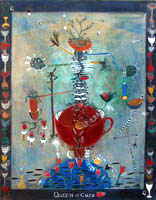The task of the right eye is to peer into the
telescope, while the left eye peers into the microscope.
Leonora Carrington, Down Below
The Paintings of Monica Aissa Martinez are an intricate blend of science, alchemy,
myth and magic. Her work recalls both the naive compositions of folk and primitive
art and the delicate renderings of the painter Paul Klee. Born in El Paso, Texas
of Mexican-American descent, Martinez was raised in a traditionally Catholic
environment that exposed her to the rituals and symbols of the Church and the
religious folk art of Mexico. She is drawn to small devotional paintings known
as retablos and ex-votos, and has adapted the iconography, palette
and graphic qualities of this naive art to create her own form of narrative
paintings. She displays a strong kinship to the women artists of the Surrealist
movement, especially Remedios Varo and Leonora Carrington.
Varo and Carrington, noted for their haunting portrayals of the subconscious,
based their work on individual experience and translated their personal realities
into boldly imaginative paintings. Like these women Martinez's paintings reflect
a serious exploration of her interior life. Much of her work stems from curiosity
about such diverse subjects as religious practice, anatomy, physiology, physics
and ancient myth. Drawing from these sources she combines and adapts many of
the parallels she observed to formulate her own answers to larger questions
about the nature of the universe.
élan vital (literally 'vital ardor'), the exhibition's title,
refers to the term elaborated by the French philosopher Henri Louis Bergson
(1859-1941). In his book Creative Evolution, Bergson defines élan
vital as "the creative force within an organism that is able to build
physical form and to produce growth and necessary or desirable adaptation."
For Martinez, the term makes broad reference to her underlying philosophy about
life and the process of making art.
Martinez's belief that all living forms are created out of a persistent natural
force is the focus on her current body of work. In her paintings, the artist
explores the physical and spiritual qualities of the feminine psyche through
metaphors associated with the body. Generously-shaped flasks, bottles, vases,
and other decidedly female vessels are reminiscent of ancient carvings of fertility
goddesses. Figures are usually centered, precisely balanced, with a multitude
of appendages and trees emerging from the tops of their heads. Many pieces appear
to be autobiographical and titles such as What am I? and I am That
reflect the artist's personal quest. A number of works are patterned after the
Tarot, a deck of allegorical cards representing the four basic forces of nature
(earth, air, fire, water) and the morality of mankind. In The Queen of Pentacles,
1996, Martinez mixes magical signs like the pentacles (a five pointed interlocking
star) with symbols abstracted from science creating a figure with goddess-like
significance and power. As in her other work, the body is represented by a container-a
bountiful vessel in the shape of an over-ripe pomegranate. Seeds tumble from
the figure's torso and sprout, branching and blooming around her.
Martinez's compositions are filled with energy. She creates laboratories of
activity-places where cups and cauldrons of mysterious concoctions bubble and
overflow their edges, spit and simmer releasing ribbons of encoded messages
and symbols into the air, uniting mind, body and spirit.
Nothing is in stasis; Martinez is the magician/alchemist striving to distill
impurities and transmute her subjects into gold, creating alternate worlds of
cosmic scope and microscopic intimacy.
Monica Aissa Martinez studied at New Mexico State University in Las Cruces
and earned her Master of Fine Arts degree in 1991. She lives and works in Phoenix,
Arizona.
Debra l. Hopkins
Curator of Exhibitions
Scottsdale Center for the Arts
New Directions Gallery
1998
|
